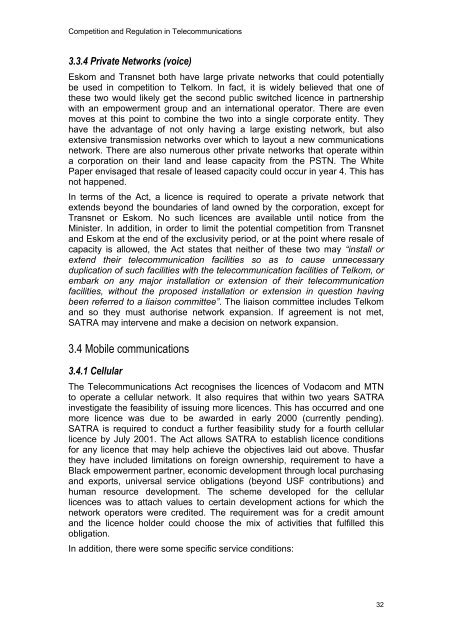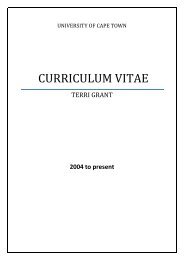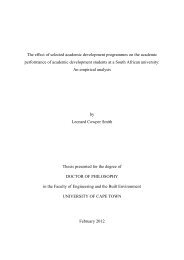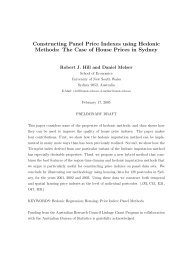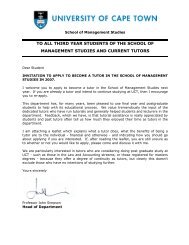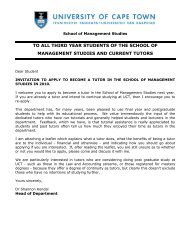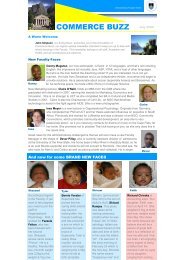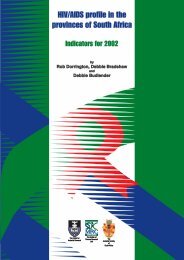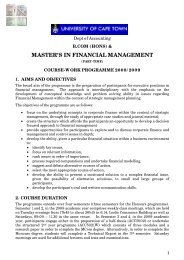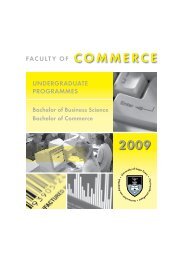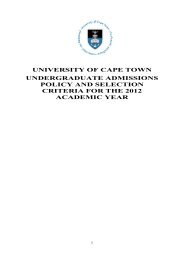Competition and Regulation in the Telecommunications Industry in ...
Competition and Regulation in the Telecommunications Industry in ...
Competition and Regulation in the Telecommunications Industry in ...
You also want an ePaper? Increase the reach of your titles
YUMPU automatically turns print PDFs into web optimized ePapers that Google loves.
<strong>Competition</strong> <strong>and</strong> <strong>Regulation</strong> <strong>in</strong> <strong>Telecommunications</strong>3.3.4 Private Networks (voice)Eskom <strong>and</strong> Transnet both have large private networks that could potentiallybe used <strong>in</strong> competition to Telkom. In fact, it is widely believed that one of<strong>the</strong>se two would likely get <strong>the</strong> second public switched licence <strong>in</strong> partnershipwith an empowerment group <strong>and</strong> an <strong>in</strong>ternational operator. There are evenmoves at this po<strong>in</strong>t to comb<strong>in</strong>e <strong>the</strong> two <strong>in</strong>to a s<strong>in</strong>gle corporate entity. Theyhave <strong>the</strong> advantage of not only hav<strong>in</strong>g a large exist<strong>in</strong>g network, but alsoextensive transmission networks over which to layout a new communicationsnetwork. There are also numerous o<strong>the</strong>r private networks that operate with<strong>in</strong>a corporation on <strong>the</strong>ir l<strong>and</strong> <strong>and</strong> lease capacity from <strong>the</strong> PSTN. The WhitePaper envisaged that resale of leased capacity could occur <strong>in</strong> year 4. This hasnot happened.In terms of <strong>the</strong> Act, a licence is required to operate a private network thatextends beyond <strong>the</strong> boundaries of l<strong>and</strong> owned by <strong>the</strong> corporation, except forTransnet or Eskom. No such licences are available until notice from <strong>the</strong>M<strong>in</strong>ister. In addition, <strong>in</strong> order to limit <strong>the</strong> potential competition from Transnet<strong>and</strong> Eskom at <strong>the</strong> end of <strong>the</strong> exclusivity period, or at <strong>the</strong> po<strong>in</strong>t where resale ofcapacity is allowed, <strong>the</strong> Act states that nei<strong>the</strong>r of <strong>the</strong>se two may “<strong>in</strong>stall orextend <strong>the</strong>ir telecommunication facilities so as to cause unnecessaryduplication of such facilities with <strong>the</strong> telecommunication facilities of Telkom, orembark on any major <strong>in</strong>stallation or extension of <strong>the</strong>ir telecommunicationfacilities, without <strong>the</strong> proposed <strong>in</strong>stallation or extension <strong>in</strong> question hav<strong>in</strong>gbeen referred to a liaison committee”. The liaison committee <strong>in</strong>cludes Telkom<strong>and</strong> so <strong>the</strong>y must authorise network expansion. If agreement is not met,SATRA may <strong>in</strong>tervene <strong>and</strong> make a decision on network expansion.3.4 Mobile communications3.4.1 CellularThe <strong>Telecommunications</strong> Act recognises <strong>the</strong> licences of Vodacom <strong>and</strong> MTNto operate a cellular network. It also requires that with<strong>in</strong> two years SATRA<strong>in</strong>vestigate <strong>the</strong> feasibility of issu<strong>in</strong>g more licences. This has occurred <strong>and</strong> onemore licence was due to be awarded <strong>in</strong> early 2000 (currently pend<strong>in</strong>g).SATRA is required to conduct a fur<strong>the</strong>r feasibility study for a fourth cellularlicence by July 2001. The Act allows SATRA to establish licence conditionsfor any licence that may help achieve <strong>the</strong> objectives laid out above. Thusfar<strong>the</strong>y have <strong>in</strong>cluded limitations on foreign ownership, requirement to have aBlack empowerment partner, economic development through local purchas<strong>in</strong>g<strong>and</strong> exports, universal service obligations (beyond USF contributions) <strong>and</strong>human resource development. The scheme developed for <strong>the</strong> cellularlicences was to attach values to certa<strong>in</strong> development actions for which <strong>the</strong>network operators were credited. The requirement was for a credit amount<strong>and</strong> <strong>the</strong> licence holder could choose <strong>the</strong> mix of activities that fulfilled thisobligation.In addition, <strong>the</strong>re were some specific service conditions:32


